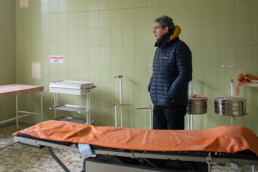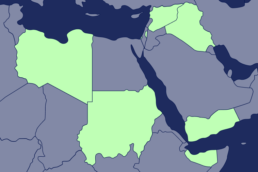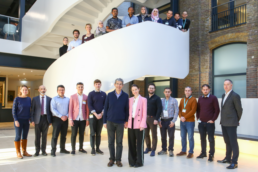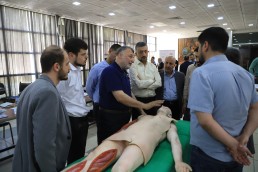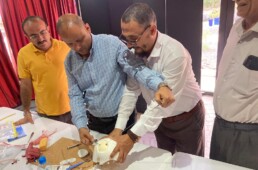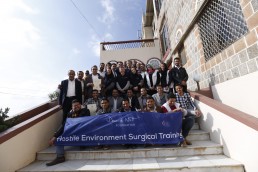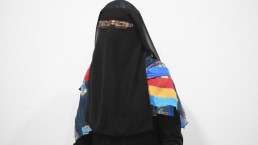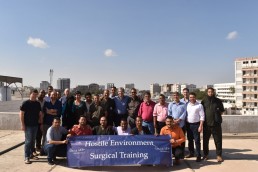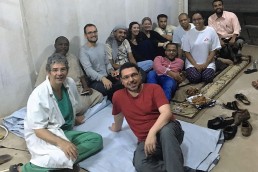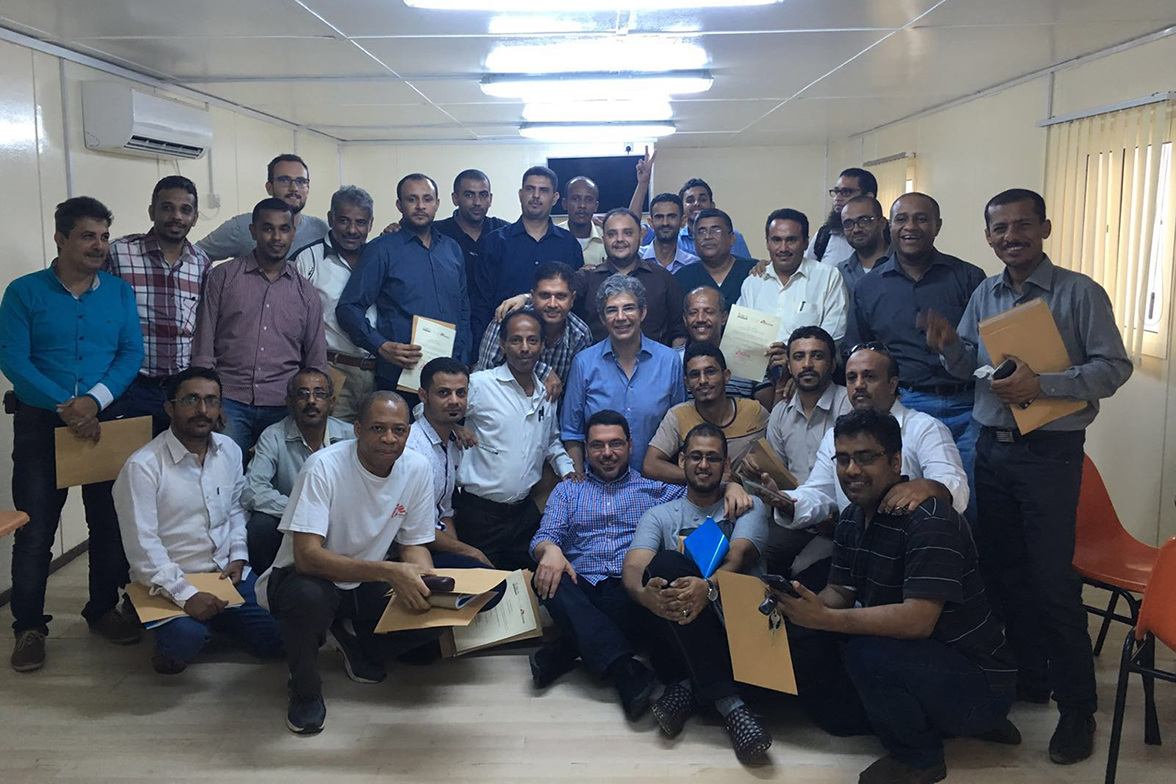Leaving a lasting legacy with 14 Yemeni surgeons
Dr Shabnam Parkar is a Consultant Paediatric Surgeon at St George’s Hospital in Tooting. After many years treating children in the UK and providing medical care in Nepal, Dr Parkar has joined our team as a surgical trainer. Last month, she led paediatrics and co-led abdominal surgery on our Hostile Environment Surgical Training (HEST) course in Djibouti, empowering 14 Yemeni surgeons with the skills needed to treat children’s trauma injuries.
Faculty Lead: Dr Ammar Darwish. Faculty Trainers: Dr Pete Mathew, Dr Shabnam Parkar, Dr Timo Bullmann, Dr Mohammed Ayman Alshiekh, Dr Jen Oliveira-Davies. Programmes Lead: Chevon Cumberbatch.
Yemen is a territory scarred by conflict. The state’s historic unrest is complex, with civil war, tribal tensions and extremist groups operating across the country. On-the-ground partners share that Yemeni surgeons commonly face injuries inflicted by war, such as gunshot wounds or landmine injuries requiring amputations. Car accidents are also common on uneven roads, leading to severe crush wounds or internal bleeding that demand urgent damage control.
Our teaching faculty, including the latest addition to our training team, Dr Shabnam Parkar, recently upskilled 15 Yemeni doctors in Djibouti, giving them the skills needed to better treat the injuries they see on a daily basis.
Dr Parkar led the paediatric module of our course, helping doctors understand how to use their surgical skills to give children with devastating injuries the very best chance of survival.

The power of education
Speaking with Dr Parkar about her humanitarian history, she shared: “For the past 10 years, I’ve worked with a charity called Health Partnership Nepal providing medical relief. We run health camps, offering medical care to 500 children and adults a day and performing minor surgeries in rural areas.
Every year, we knew we were doing good work, but it felt like applying a temporary plaster to a wound. We weren’t getting to the source or really identifying what the country’s core needs were. The charity’s direction fell into place when I was invited to operate on left-over cases from a previous mission.
I thought, why don’t I teach the local doctors how to perform safe inguinal hernia surgery, rather than patients waiting for my annual visit? A sustainable model of teaching. Today, Health Partnership Nepal provides medical care to local communities and teaches doctors vital clinical skills such as resuscitation.
It was that same ethos of education and training at the David Nott Foundation that I was drawn to.
I worked with David as his Senior House Officer and always knew I wanted to get involved in humanitarian work. After meeting Elly Nott at an event, we stayed in touch and I was later invited to their Train The Trainers course in London. I was honoured to join the Foundation as an official trainer in Djibouti, teaching 15 Yemeni surgeons.
Training in Djibouti
The doctors were highly experienced and mainly consisted of general, trauma, orthopaedic and vascular surgeons from all over Yemen. They received 5 days of intensive surgical training, empowering them with skills, tools and tips for better treating the complex wounds they see daily. From obstetrics to neurosurgery to mass casualty triage, the course is designed to create multi-skilled trauma surgeons that are ready to respond to a wide spectrum of injuries.
Many were familiar with how to handle damage control surgery and use skin flaps to treat large open wounds, however we got great feedback on orthopaedics and paediatrics, and the group discussions were fantastic.
It was lovely to see them presenting cases on their phones and sharing ideas of how they approach surgery with each other. The course created a platform for Yemeni doctors to connect and support each other, no matter the region they worked in.
The team really felt like a family – and everyone helped ensure the course was delivered to the highest standard for the doctors we met.”
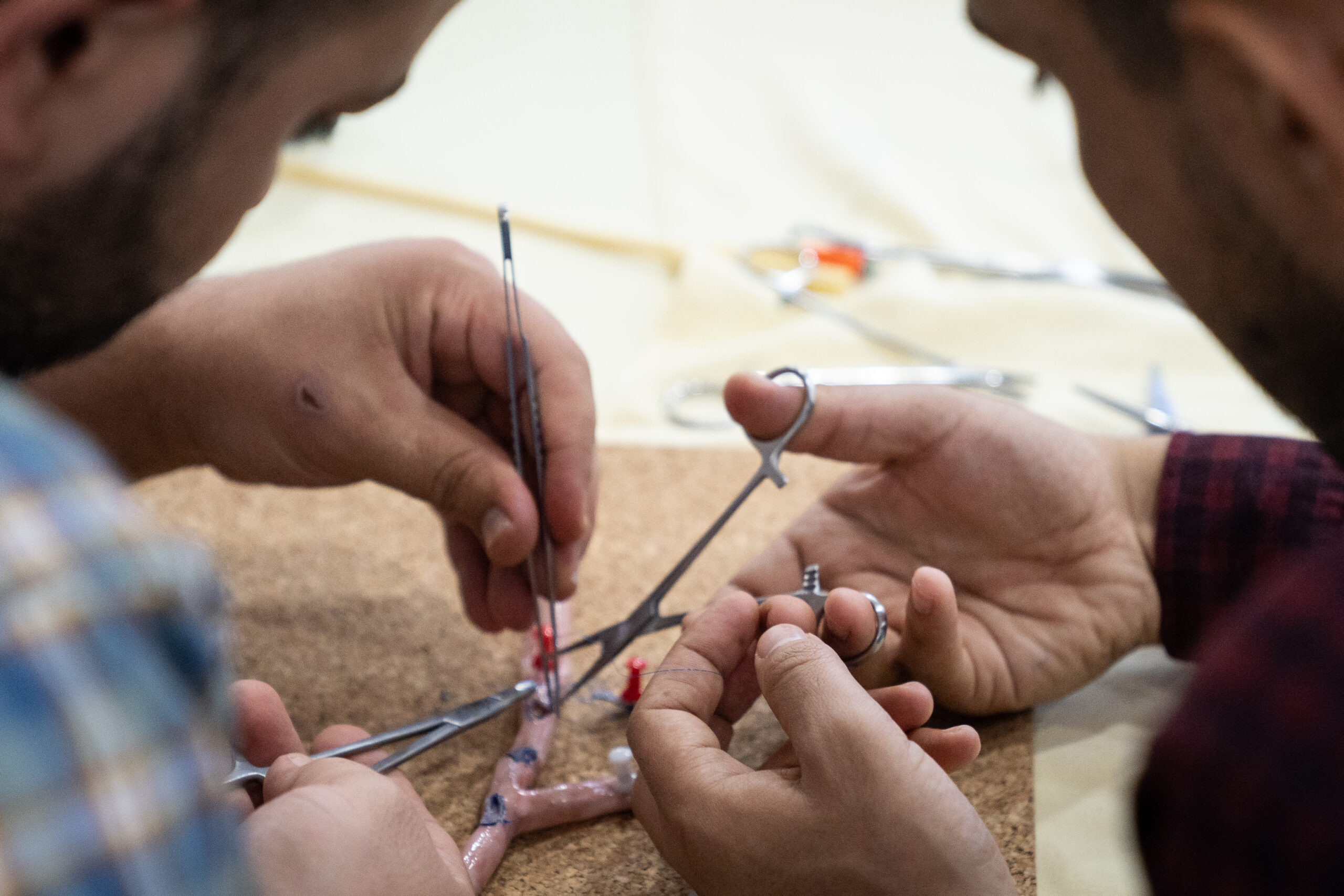
A strengthened healthcare system
One participant shared, “Working in any war zone, I know I can use my new skills,” while another said they were more confident and that they could “face any emergency case” as a result of their training.
Our CEO and Co-Founder, Elly Nott, said: “This was our fifth mission with doctors from Yemen and we were honoured to have the opportunity to further expand the state’s network of skilled surgeons and strengthen their healthcare system.
No matter the conflict or disaster, we are passionate about empowering surgeons with skills we know can make the difference between a patient’s life or death.
Education is incredibly powerful – it forms the backbone of our Foundation. We look forward to future courses, led by our talented trainers, that will continue to benefit communities in Yemen.”
To see our training in action, watch our Palestine story
Operating and Teaching in Yemen: an Interview with David Nott
In April, David travelled to Yemen with Ammar Darwish, Mounir Hakimi and Asan Raffee to deliver both teaching and hands-on surgery in the World's worst humanitarian crisis. Below is a short interview that we conducted with him on his return.
How did this trip come together?
It came about with a telephone call from Syria Relief. Mounir Hakimi (of Syria Relief) had been in contact with several of the doctors who had been working in Marib. They were operating on a large amount of cases and they wanted help. Some of the surgeons who were there had difficult wounds or injuries presenting, and they wanted advice and teaching on how to cope with those injuries. That was how we heard about it.
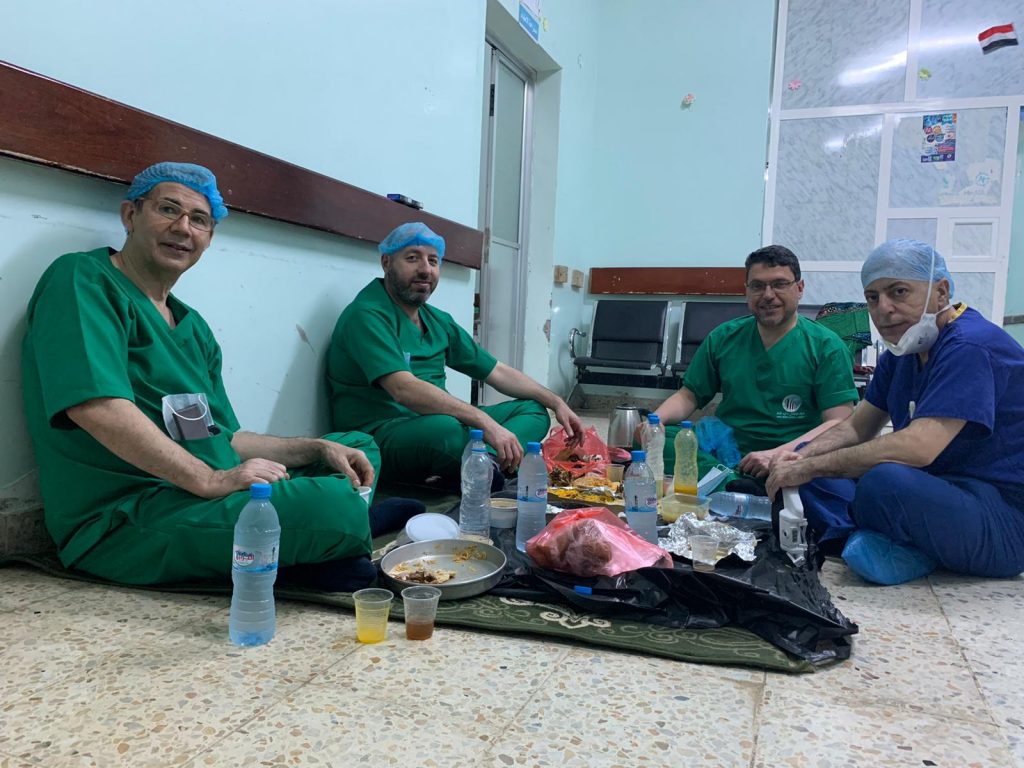
The Syria Relief - DNF Team break their fast in Marib.
What did you see of the city of Marib?
It was pitch black at night when we arrived. We landed in Seiyun and it was a 6 or 7 hour drive to Marib. We arrived very early in the morning and went to a hotel local to the hospital. A few hours later, in the morning, we went to the hospital and were very much welcomed by the medical team working there.
What was the hospital like?
We had a very nice tour around. The Medical Director was extremely enthusiastic in showing us exactly what they had been able to continue to do. They had a very good blood transfusion bank, they had very good blood chemical laboratories. They had an intensive care unit, they had well-stocked theatres and they had a good array of back-up support. There were a lot of nurses on the wards.

At the time, Marib was becoming the epicentre of the civil war. Could you see that that hospital and its staff had been affected by escalating conflict within and around the City?
Yes. It was the epicentre. And it still is. The fighting is intense. Probably about 15km north of Marib. At the moment, Marib has about two million refugees and it is very densely populated. The fighting is continuing and obviously the hospital that we were in was the frontline hospital to accept all those casualties that were wounded. Both civilian and non-civilian.
We heard jets going over the top and we also heard rockets coming into Marib. You were aware that you were in a very hot war zone.
Who did you meet at the hospital?
Some were senior doctors. Some had just come in the last couple of months from Egypt to help out. There were quite junior doctors. There were those that required quite a lot of teaching and understanding of how to manage injuries. The hospital had stopped almost all of its elective surgeries. They were focusing purely on the war-wounded patients. Unfortunately those patients that had cancer problems weren’t really dealt with at this time.
Which case stands out the most in your memory?
I think the case that stood out most was after the teaching we gave the night before on gunshot wounds to the chest and abdomen. The surgeons had never done a thoracotomy before for a gunshot wound to the chest. The following night we were called back to the hospital with a surgeon who had watched our lecture and we found there was a patient who needed a thoracotomy. Because we were there, we were able to show him exactly how to do it and exactly how to extend this incision onto the abdomen and do a thoracoabdominal procedure. The patient did extremely well and thanked us a couple of days later.
We discussed a lot of reconstructive work. Most of the flaps that we discuss on our HEST course, we did in Marib. There was a lot of surgery done with a view to the surgeons being able to do that kind of surgery when we left.
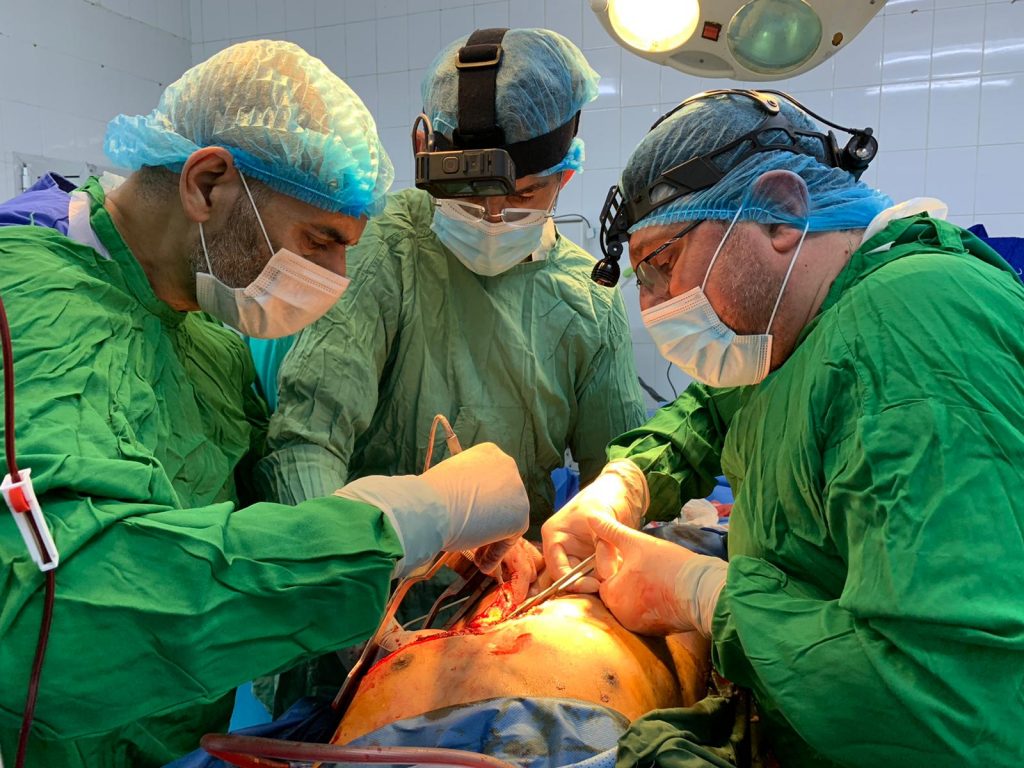
Going forward, what do you think the Foundation's work in Yemen is going to look like?
I think that we will be going back to Marib, and I think we will continue to go back and support them both with teaching the DNF HEST course and perhaps this time taking our models with us as well so that we can run a course during the day or the evening and then operate as well. I think the future of the DNF is operating as well as hands-on teaching as well as the classroom for some courses. The future lies both within the operating theatre and the classroom.
I think we had developed a significant rapport with the doctors such that I heard recently that they desperately want us to go back again to show them more and more. I think that is the perfect opportunity for the DNF to show what it is worth really.
This mission epitomised what the DNF is all about. The DNF goes out to the field, it saves lots of lives as well as teaching the doctors so that they can continue to save lives. The DNF leaves a legacy.
You can read Ammar Darwish's story of the mission here.
David Nott and Ammar Darwish Return from Yemen Mission
Surgery on the Frontlines of the Yemen Civil War
Ammar Darwish's experience of operating and teaching in the world's worst humanitarian crisis.
CONTAINS GRAPHIC IMAGES OF SURGERY
"The Yemeni medical staff in Marib sent a call for assistance as they have been extremely overwhelmed with injured patients from the war"
David and Ammar were called up by Syria Relief to assist the medical staff in the city of Marib, who were facing an unprecedented number of patients injured in the intensifying conflict of which the city had become an epicentre. The team left London excited to get back to their roots, operating in areas of conflict and austere environments.The team left London ready to begin the long journey to Yemen, where they would meet with Syria Relief - a charity that provides support to Syrians needing medical intervention, food, education and other necessities. The team arrived at Seiyun airport in Yemen, and travelled through the night to reach the hospital in Marib that was to be their home for the next two weeks.

Marib is just 10 or 15 kilometres from the front-line of fighting, a grim reality that was ever-present as the team arrived and changed immediately into their theatre clothes.
After meeting the local medical team David, Ammar, Mounir and Dr Asan Rafee had a quick tour and then immediately started working. For the patients at this trauma centre, there was no time to lose.
![[object Object]](https://media.shorthand.com/media/organisations/Sn3h4o86N0/HrtyxtQmDd/whatsapp-image-2021-05-21-at-17-11-13-1600x1200.jpeg)
"This is one of the first operations that we dealt with. A gunshot wound to the abdomen in a young man who was left in a state of shock. He bled a lot and we had to do a trauma laparotomy and damage control surgery. We operated on him immediately.
David is just behind me in the background. He is getting ready to go to another theatre to deal with another case."



"Again, another abdominal injury to a patient. We are doing an emergency trauma laparotomy and treating the patient. David, Myself and one of the local surgeons".
Although the local surgeons are very experienced, they have not dealt with many of these cases before. David and Ammar spent many hours training the local surgeons, imparting their years of knowledge gained through war surgery and taking them through complex operations.
They opened the chest to stop the bleeding, performed damage control surgery and took the patient into intensive care. All the while, David and Ammar were teaching their local counterpart how to perform this procedure, and to deal with these injuries.
After 7 days, the patient was discharged. His life had been saved.

"This is the team after a long day of operating, dealing with different kinds of injuries. We sat down, I think it was almost 8 O'clock in the evening to break our fast after a long day of operating - I think 12 or 13 hours of operating".

"When everything had calmed down, especially at night, we used to give teachings. David gave lectures on different kinds of injuries and how to manage those injuries. David did the main teaching, and Mounir and I helped to translate".
The team did around 45 operations in Yemen. This ranged from life-saving trauma surgeries to complex reconstructive surgeries.
They returned home to the UK ready to deploy again as soon as possible, to wherever they are needed.

The mission itself was organised and conducted by Syria Relief. Head to their website (https://syriarelief.org.uk/about-us/) to learn more about them.
Yemen HEST January 2020
The DNF team, in partnership with MSF Spain, recently returned from our latest mission to Yemen which brought in 31 surgeons from across the country for a specialised five-day training course. Since 2015, Yemen has been the stage of one of the world's worst humanitarian catastrophes. Hundreds of thousands of Yemeni citizens have already lost their lives, and as the fighting continues, many more are in need of urgent medical treatment and supplies. At the front-lines of this conflict are the surgeons and medics who face the challenge of saving lives without losing their own, all the while limited by a lack of resources and insufficient training.
Our Hostile Environment Surgical Training course (HEST) was designed to confront this problem. Over the course of five days, our Faculty, comprising David Nott, Ammar Darwish, Pippa Letchworth, Pete Mathew and Rebekka Troller instructed surgeons on a wide range of trauma topics. By equipping these medics with the necessary knowledge, confidence and skills that they need to treat patients, we can improve the medical outcome for countless people.

The regions where HEST is taught often rule out cadaveric teaching, so the Foundation’s whole body simulator, Heston, was employed for training. This state of the art, bespoke simulator mimics the look and feel of real human flesh and features the full range of organs, blood vessels and key anatomies needed for facilitating learning.
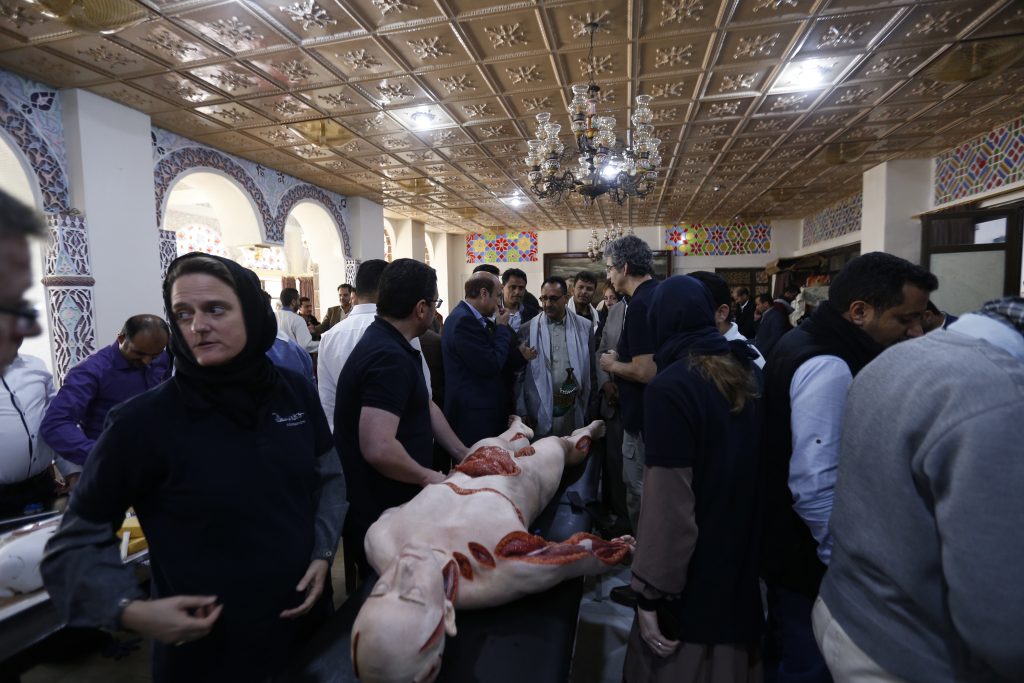
Supporting Heston, we also deployed our neonatal models and our new VR learning experience, which simulates a mass casualty event. This immersive experience focuses on the triage of ten patients using International Committee of the Red Cross categories: serious wounds, second priority, superficial wounds and severe wounds.

To date, the Foundation has trained 803 medics across 28 courses, benefiting an estimated 1.7 million patients. Through this global network of war doctors, we can raise the standard of medical care worldwide and continue to save more lives and limbs. To help us train even more surgeons, you can donate here.
War Doctor Heroes: Meet Dr Samah
We are proud to introduce Dr Samah in the latest instalment of our War Doctor Heroes. These features share the stories of our global family of surgeons. Their courage, diligence and dedication inspires everything that the Foundation strives to achieve.
Dr Samah is the only female surgeon in Aden and possibly in all of Yemen. We first met this incredible doctor in 2016 when she completed our overseas training course (HEST). Since then, she has come to be regarded as one of the very best and has consistently impressed our team with her dedication and diligence.
Earlier this year, Dr Samah was able to apply the skills learned on one of our courses in a life threatening situation. She carried out an emergency procedure whereby an incision of the skin of a patient is made to create a clear airway in a technique that is only performed as a last resort when intubation is impossible. Dr Samah told us: “I saved his life; it was great what I felt at that moment. It’s all thanks to Dr David and his Foundation.”
Her legacy is a reminder of the many extraordinary women who've been on the "front line" for years.
To help us train more war doctors like Dr Samah, you can donate here.
Yemen HEST January 2019
The David Nott Foundation ran two HEST courses in Aden, Yemen in January 2019 with the support of Médecins Sans Frontières.

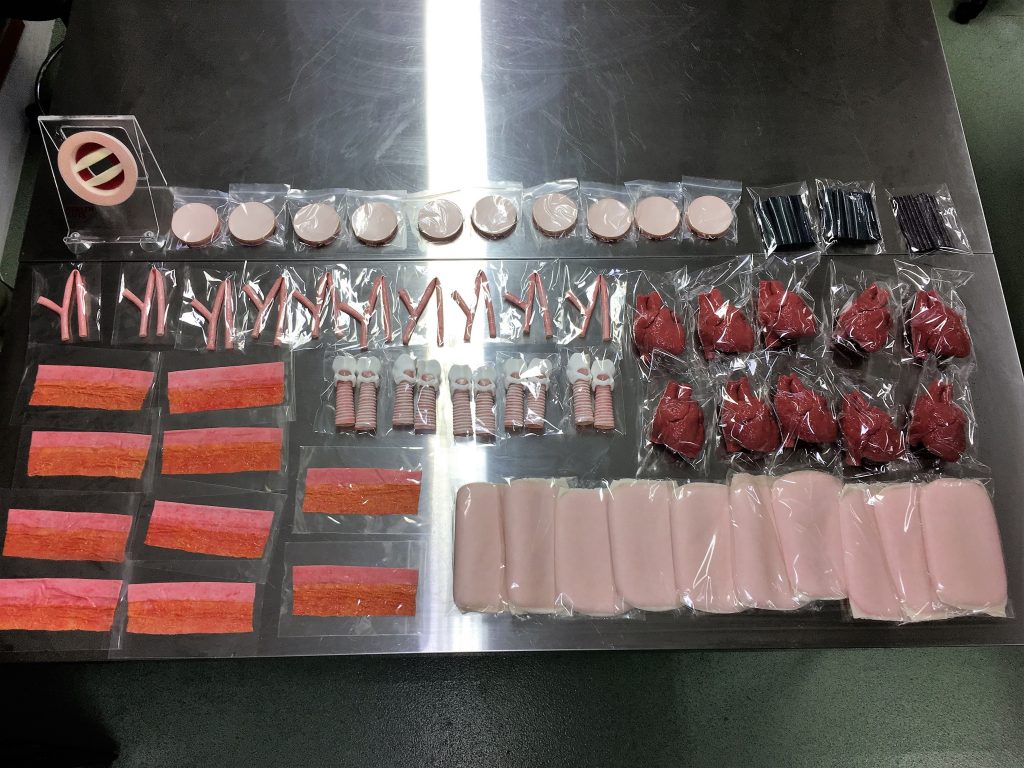
These two HEST courses were the first occasion that the Foundation’s whole body simulator was employed for training and supporting it was a suite of individual models of organs, blood vessels and key anatomies with which the students could train. For the obstetrics modules, the Faculty used its commercially-sourced obstetrics simulator enabling each surgeon to practise multiple Caesarean section deliveries as well as neonatal resuscitation.
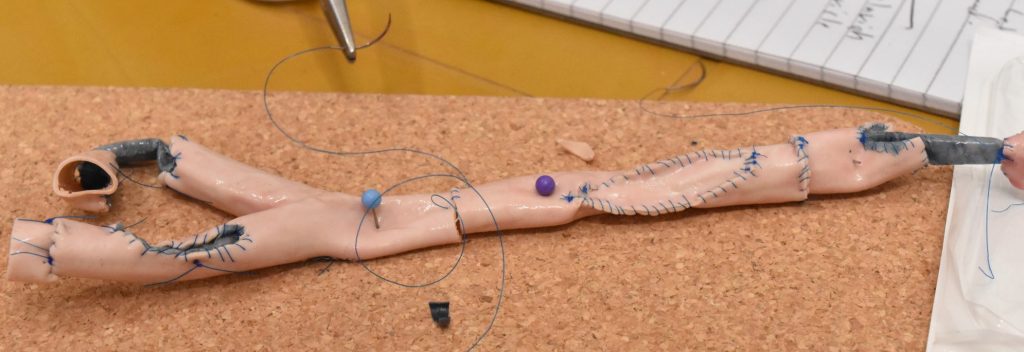
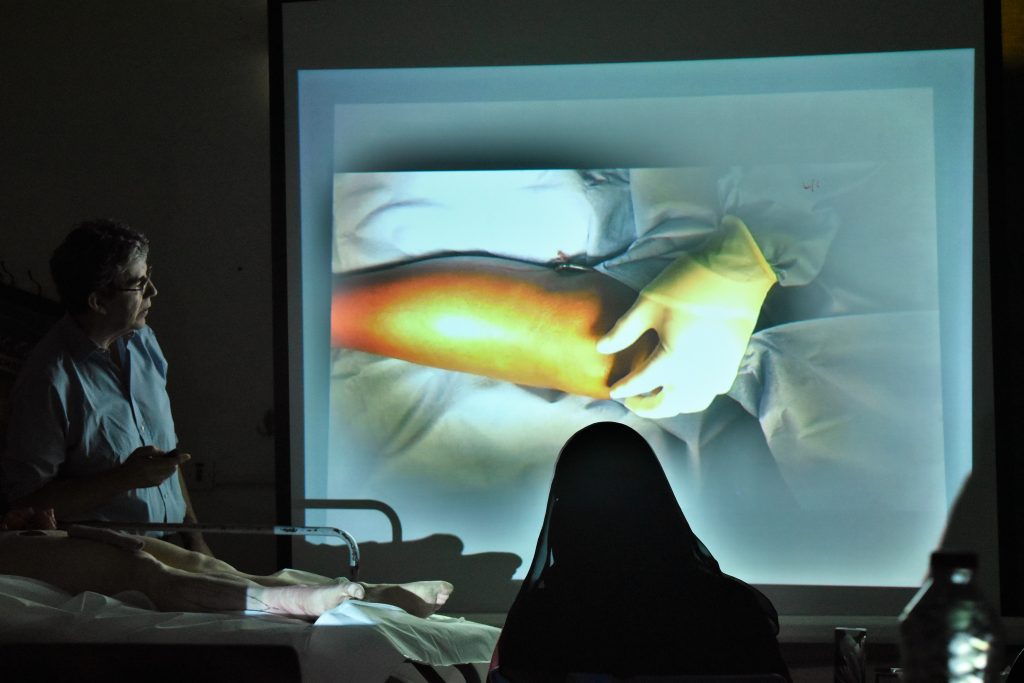
Training
Covering 2-5 hours each, the courses were taken through:
- Ballistics – the effects of low velocity bullets and high velocity bullets and the four stages of a blast injury on the human body
- Primary and secondary survey
- Damage control
- Cardio-thoracic trauma – thoracotomies; lung twist and tractotomy; effects of a cardiac tamponade; pericardial sac opening; heart suturing
- Vascular surgery – ligating, shunting, patching and grafting vessels; fasciotomies; proximal and distal control
- Head and neck trauma – removal of extracranial haematoma; burr holes and craniotomies for extradural haematoma; fragment removal with depressed skull fractures; treatment of mandibular and Le Fort fractures; jaw and maxilla wiring
- Principles of paediatric surgery – differences in physiology; burns; common injuries and diseases; cultural considerations
- Abdominal trauma – laparotomies; control of bleeding; pelvic injuries and bracing; splenectomy; Cattel-Braasch manoeuvre; Whipple procedure; bowel anastomoses; ileostomy and colostomy; closure of abdomen
- Orthopaedic surgery – stabilisation by plaster of Paris; traction; external fixation; management of difficult fracture, non-union and infection; osteomyelitis; amputations
- Plastic surgery – burns; debridement and reconstruction; skin grafts; tissue flaps
- Trauma in obstetrics and gynaecology – vaginal deliveries; Caesarean sections; hysterectomies; post-partum haemorrhage with compression techniques and tamponade; perineal trauma; retained products; ectopic pregnancy; neonatal resuscitation
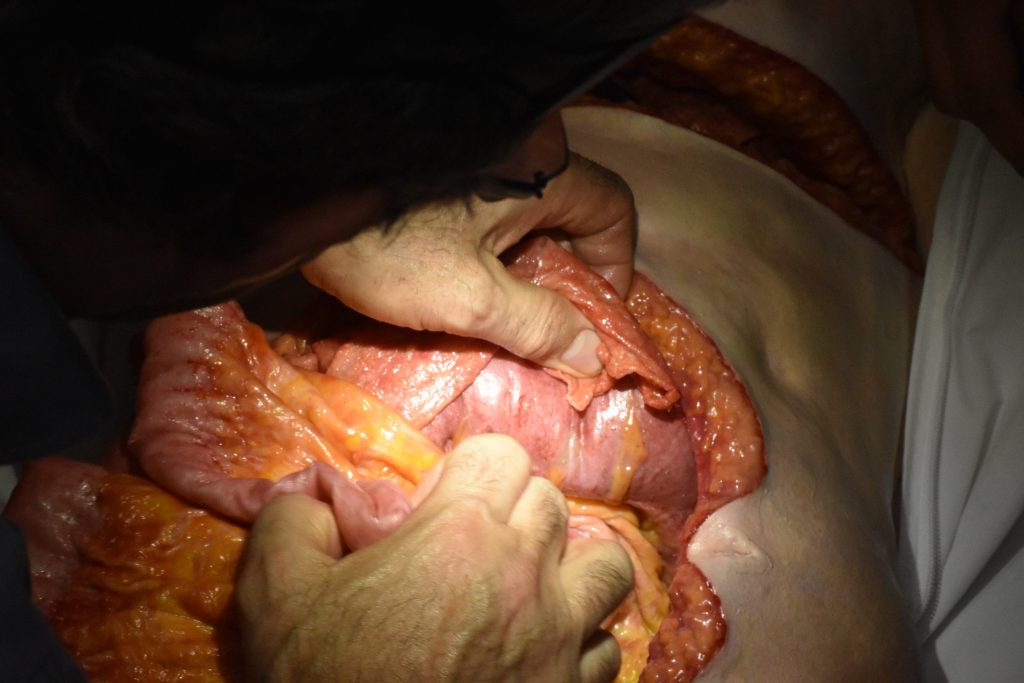
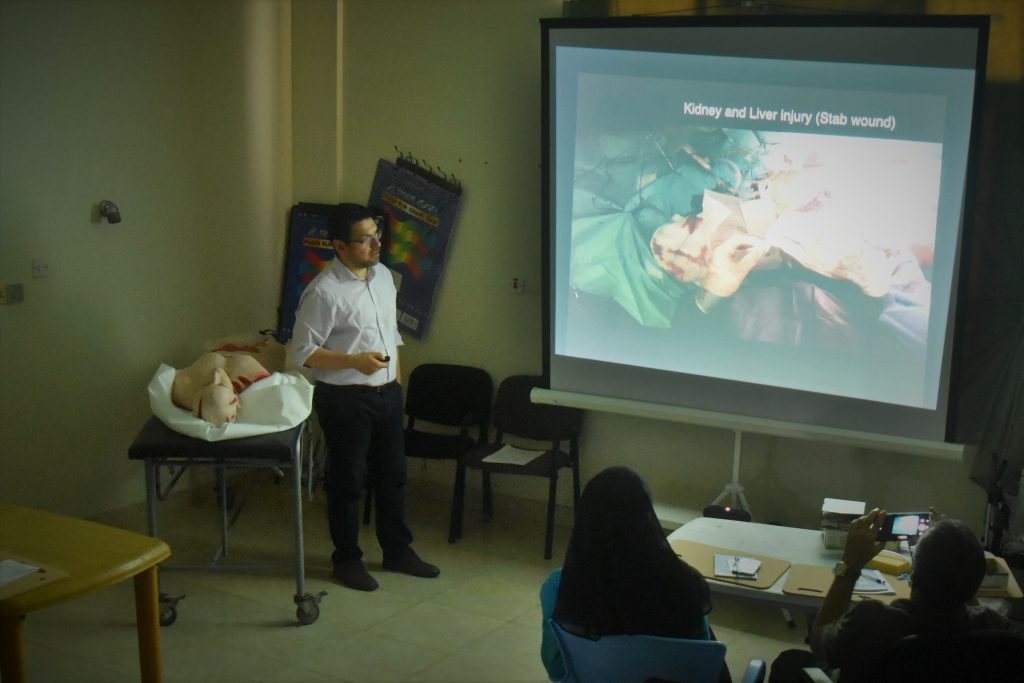

Students
The Faculty trained 52 students over the two courses. 20 surgeons and doctors from across the country came for the first week and demonstrated a high level of experience and skill, and engaged well with all the training, even putting some of it into use the same day once they returned to theatre. By the time the second course started the work had spread and many more than expected turned up to start, with some having to be turned away to keep the numbers manageable.
Particularly interesting was the attendance of five surgeons who had previously attended a HEST course delivered by David and team in Aden in 2016. Among those was a highly respected female surgeon; the only in Aden and possibly the only in Yemen, who had only recently qualified. In the three years since she had come to be regarded as a one of the best there and consistently impressed the Faculty. Such was her appetite to learn that she even sat in on some of the sessions in the second week to make sure it was all sinking in.
Conclusion
There is no doubt in our minds as to the value of the courses in Yemen and the evidence of and potential for making a very real difference to the surgical outcomes for patients not only treated by the surgeons we taught, but also those to whom the training, techniques and procedures can be cascaded.
The impact that the models have made is exceptional; they have transformed the course and are now invaluable training aids for almost all components of the syllabus. Both the surgeons that have trained with the models, and the David Nott Foundation faculty that have used it in their teaching, have been emphatically enthusiastic in their feedback about the value it brings to the training. Both the surgeons that have trained with the models, and the David Nott Foundation faculty that have used it in their teaching, have been emphatically enthusiastic in their feedback about the value it brings to the training.
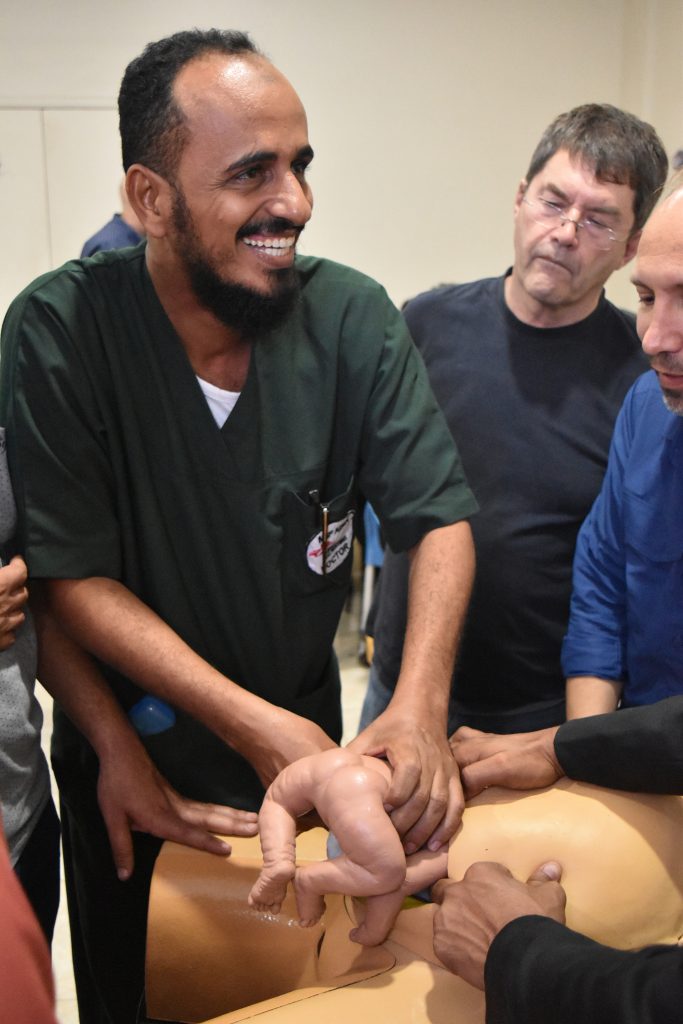
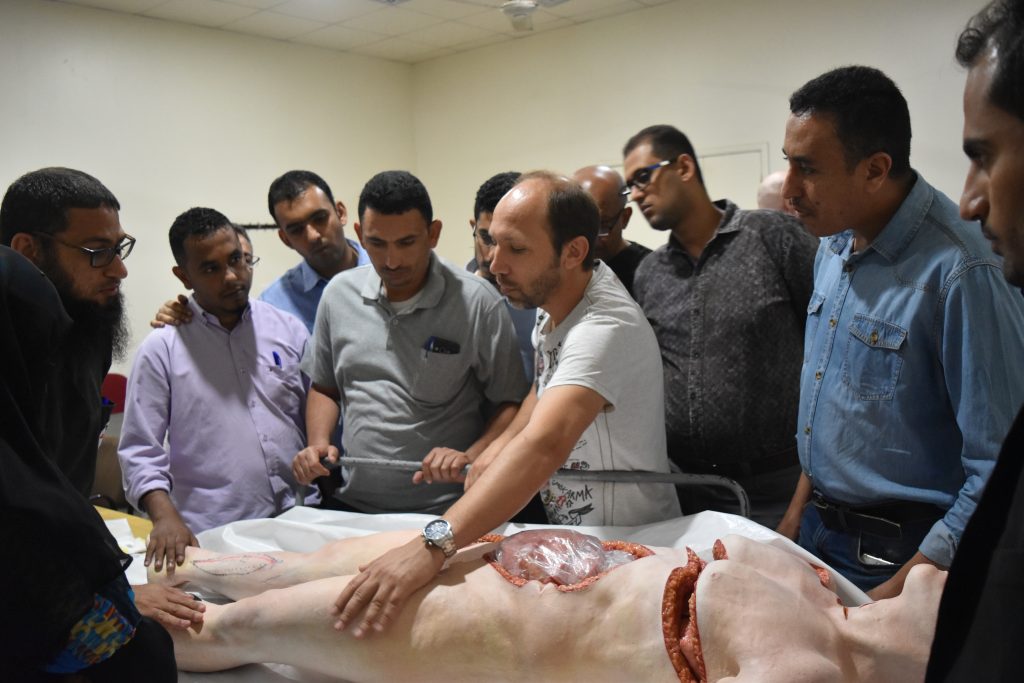
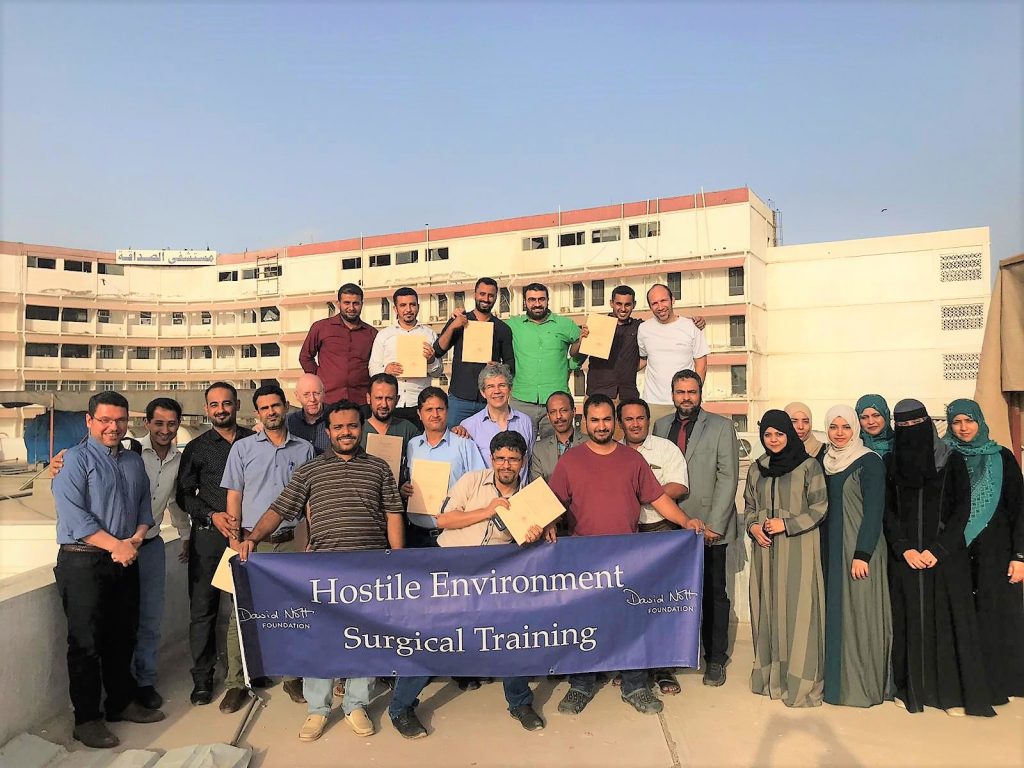
Yemen HEST July 2016
David Nott Foundation ran a HEST course in Aden, Yemen from 10-12 July, 2016. 43 surgeons from hospitals in Aden, Lahj, Abyan, Lawder and Shabwa attended the three-day war surgery training.
David showed the doctors how to treat a variety of complicated war injuries, principally fragmentation and gunshot wounds. There had been an increase in suicide bomb attacks and bombs placed under cars in recent weeks, causing horrendous blast injuries which David also showed the doctors how to treat.
The Foundation taught the course at the invitation of Médecins Sans Frontières (MSF) as part of their regular training for local doctors and nurses.
David said: “I was thrilled to receive the invitation from MSF to run the HEST course in Yemen and am delighted to say we have had more invitations to run courses from other aid agencies in various countries. It shows the huge importance of the work we are doing and the very real need for surgical training in war zones.”
